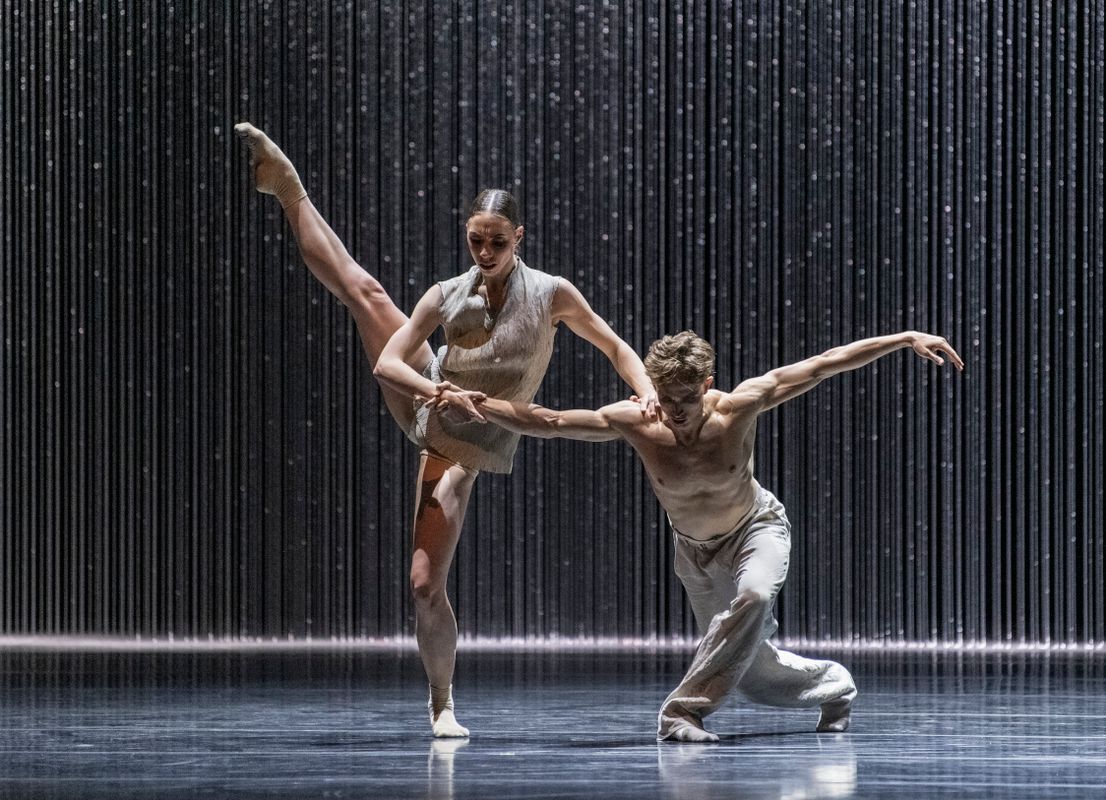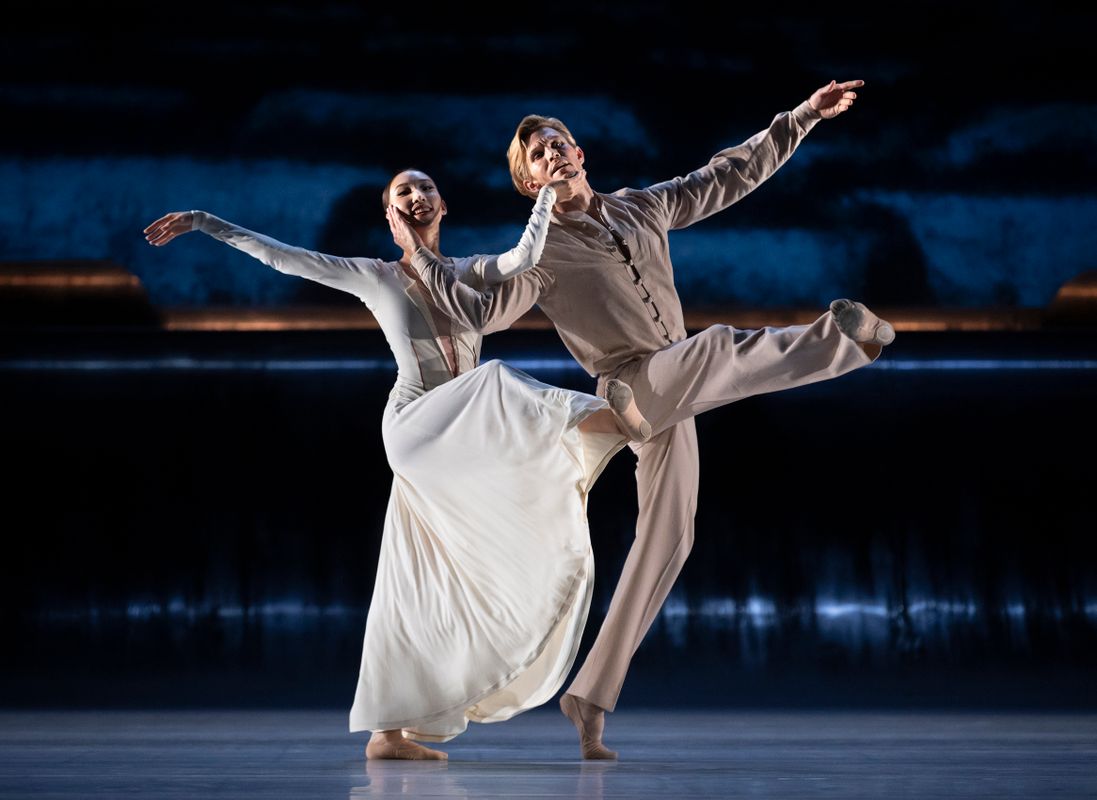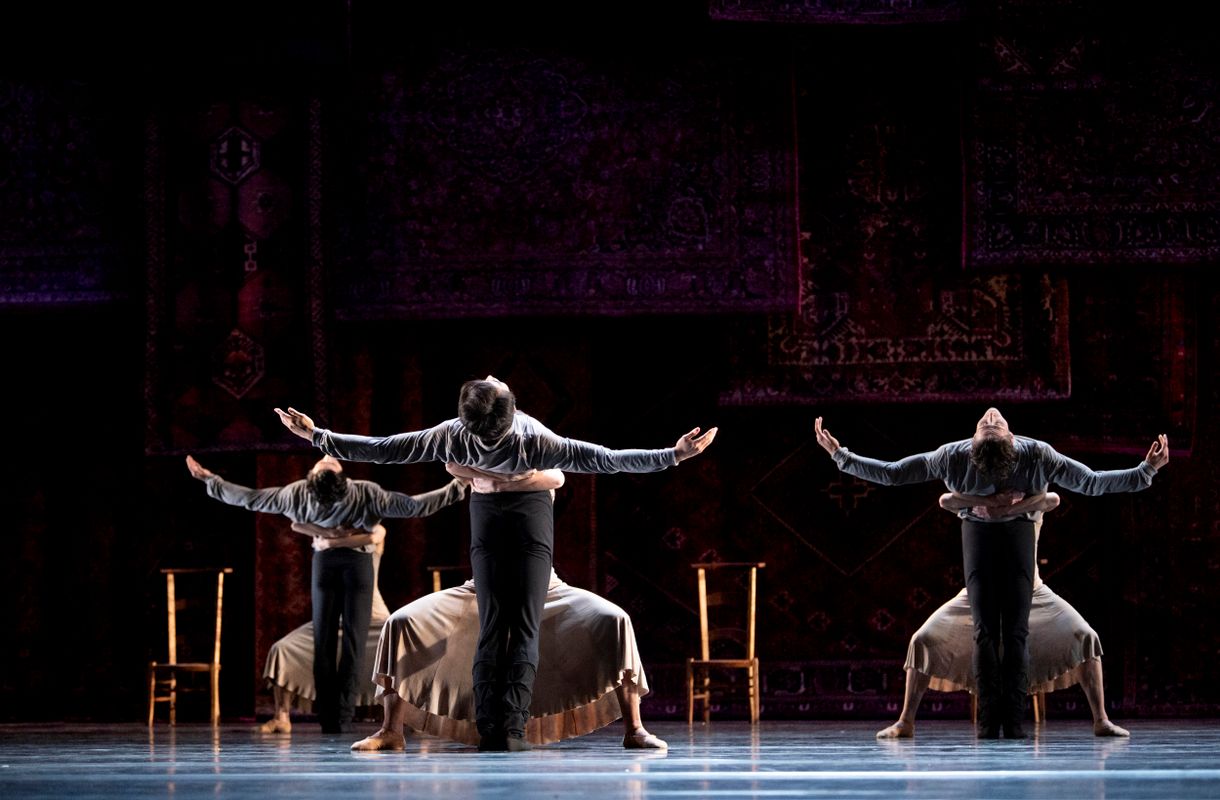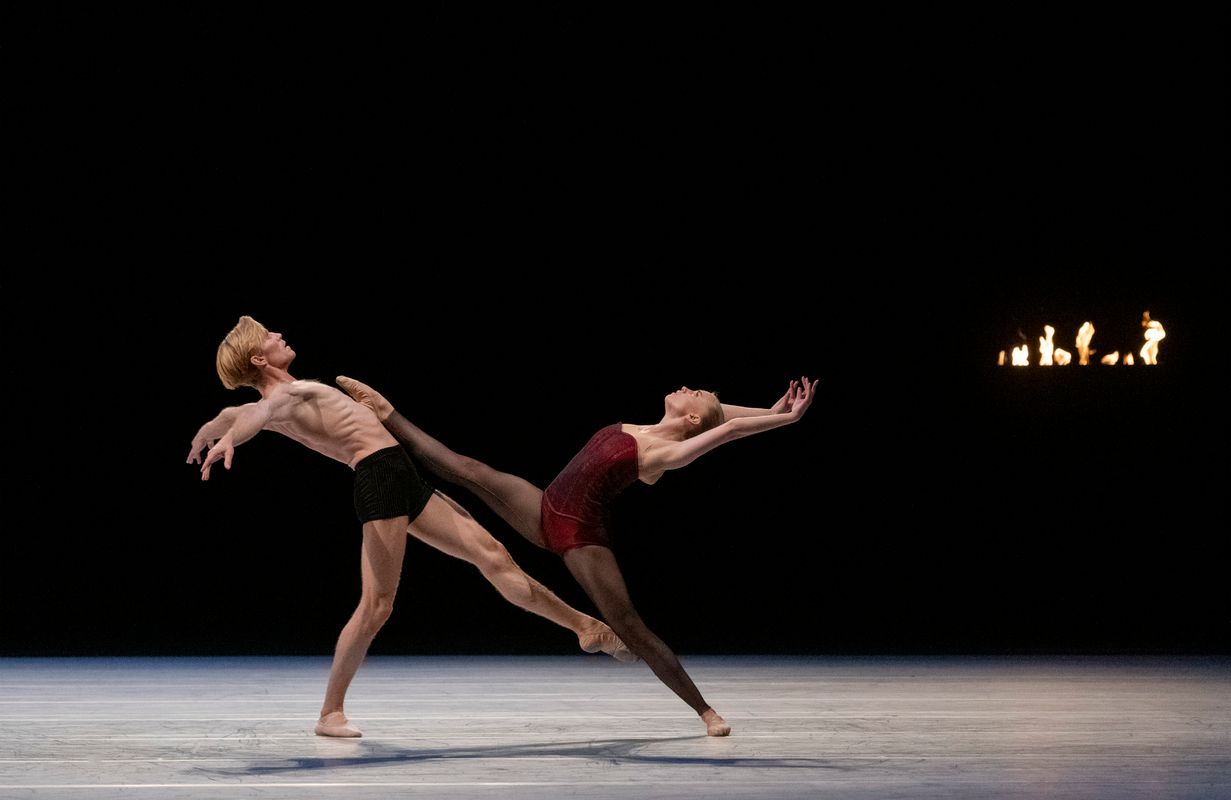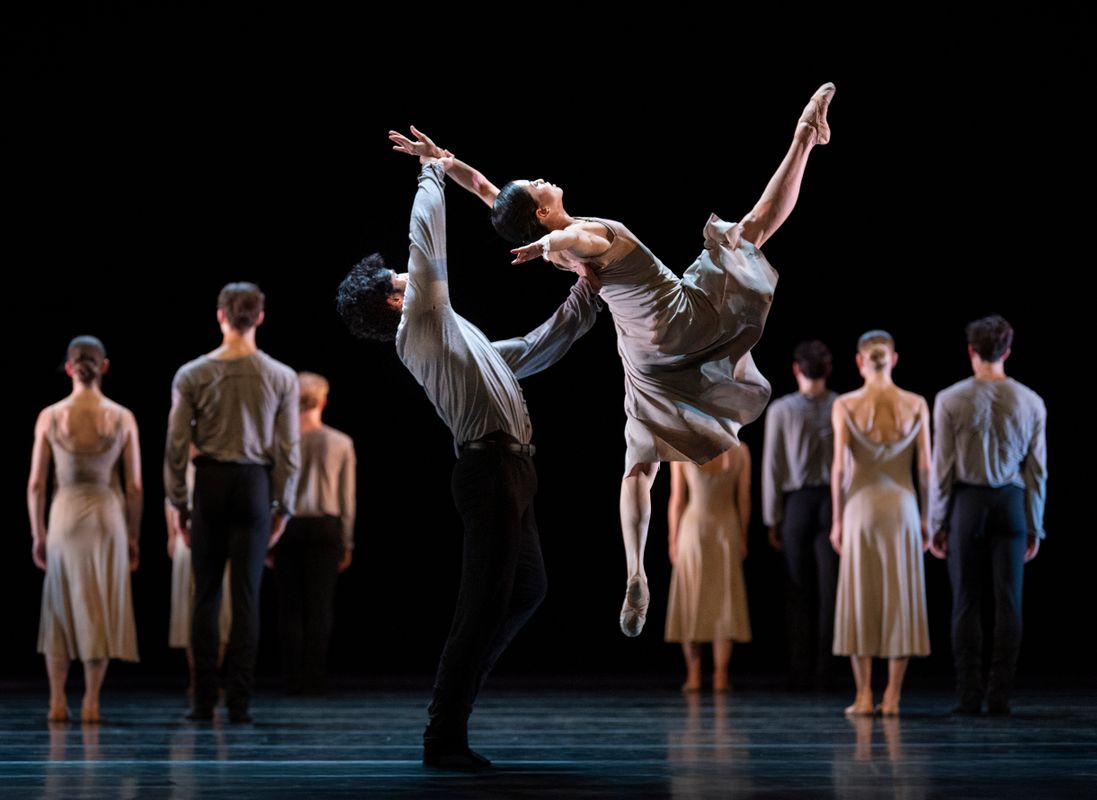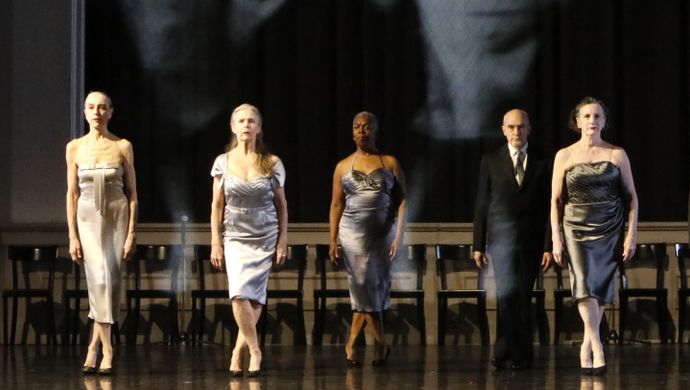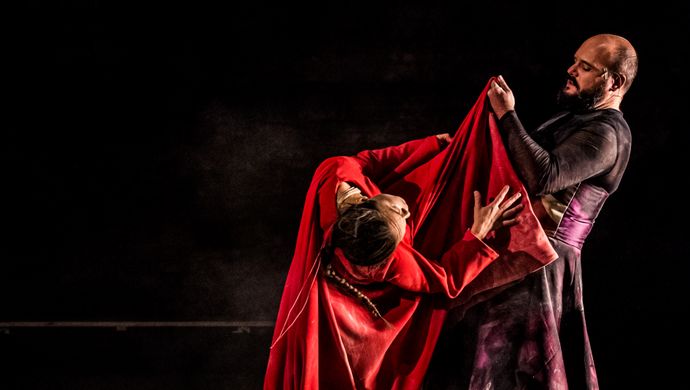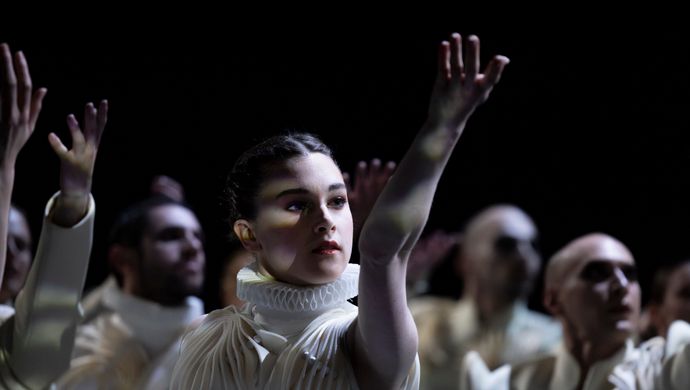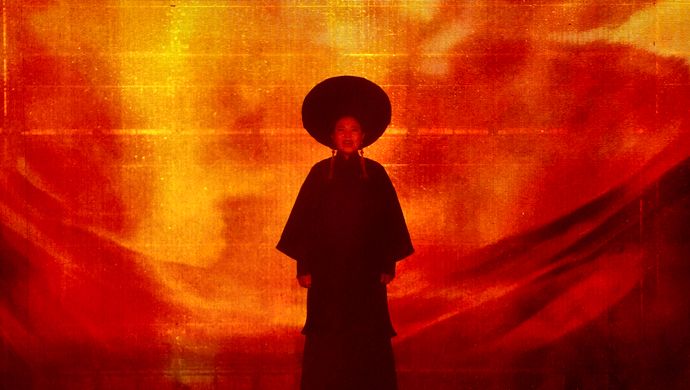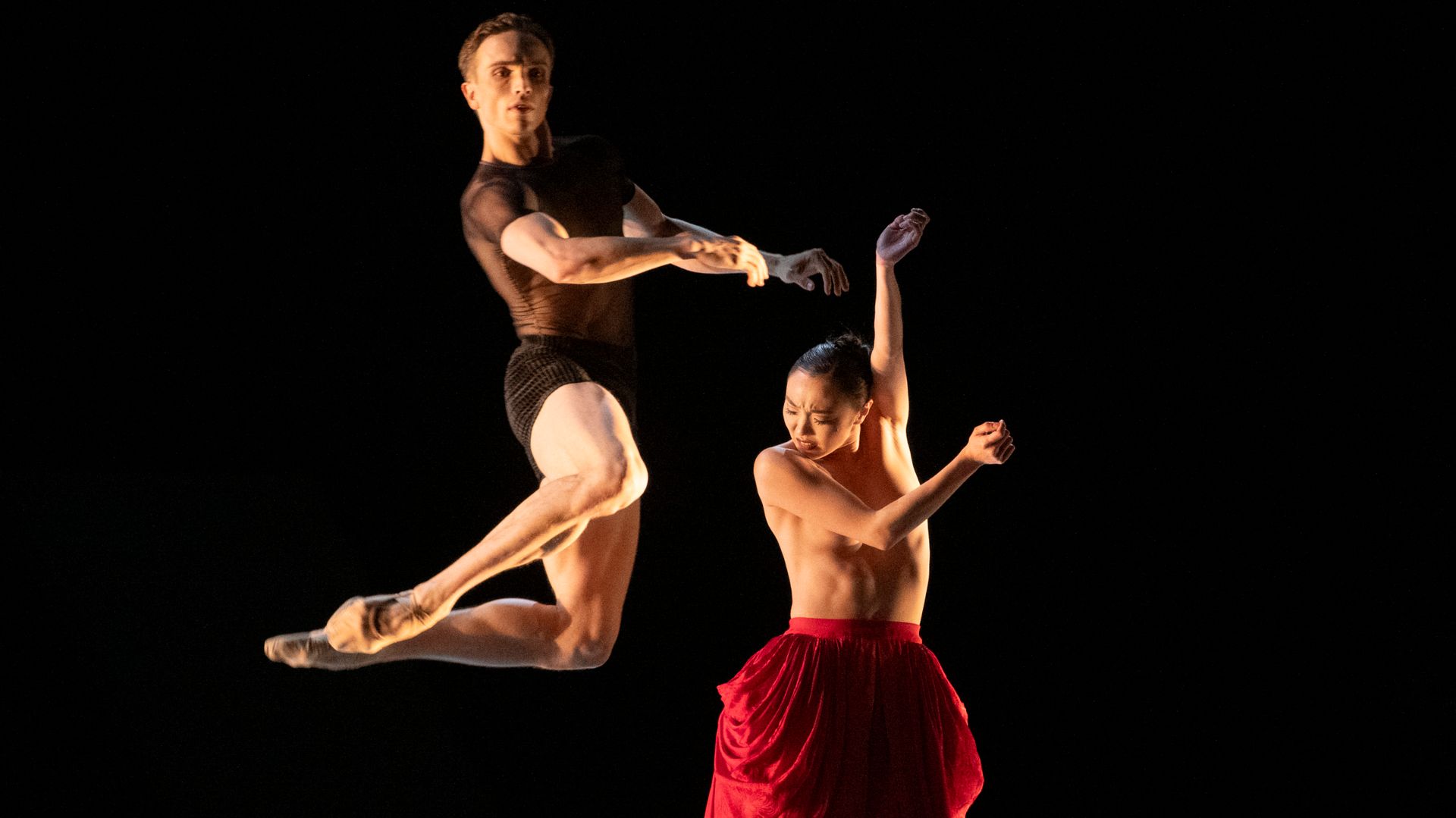
Jiří Kylián Retrospectief: WINGS OF TIME
The Norwegian National Ballet
Co-presentation Holland Dance Festival, Kylián Productions, Amare and supported by FIND
wed 18 to sun 22 June / Danstheater
Program:
Day after Yesterday (wed 18 & thu 19 Jun)
1978 - 1991 by Jiří Kylián
Forgotten Land
No More Play
Petite Mort
Symphony of Psalms
Day before Tomorrow (sat 21 & sun 22 Jun)
1995 - 2008 by Jiří Kylián
Wings of Wax
Gods and Dogs
Bella Figura
Program Explanation:
Day after Yesterday
Four timeless ballets guide you through the masterpieces of Kylián’s early career.
1 - Forgotten Land
In 1939, Benjamin Britten received a commission to write a score that would be used as part of the celebrations commemorating the 2600th anniversary of Japan’s existence. Britten accepted the commission and wrote a work entitled Sinfonia da Requiem.
But the fact that he used Latin Christian liturgical text as an underlying theme led to the rejection of his composition by the nationalist government of Japan.
Sinfonia da Requiem is divided into three parts: Lacrymosa (Weeping), Dies Irae (Gods Wrath) and Requiem Aeternam (Eternal Rest). Eventually, Britten decided to dedicate this work to the memory of his parents. A very important source of inspiration for my choreography was the famous painting by Edvard Munch, Dance of Life (1899), in which a woman is portrayed in the three stages of her life. This work was conceived in close collaboration with the painter John Macfarlane, the designer of the stage set and costumes.
2 - No More Play
The basic idea for this choreography was inspired by a small sculpture by Alberto Giacometti called No More Play. It is a simple, slightly deformed sculpture with small dents and craters. One might feel like having been invited to play a board game where the rules are being kept secret, or have never been defined. But as you begin to play this strange game, you start to learn its laws – only sometimes too late.
For my choreography I have decided to use Anton Webern's music – Five movements for string quartet, Op. 5 from 1909. This music has a fascinating feeling of essence and inevitability. Its sound and structure create a very strange kind of “cool” emotionality and dynamic tension. These musical qualities had a decisive influence on my choreography. In the process, I sometimes felt as if I were playing a game with very precise rules, but rules that someone had written in a long forgotten language.
3 - Petit Mort
“Petite Mort” is a poetic and strangely significant way of describing the ecstasy of sexual intercourse in French, and in some other languages.
And it is very possible that, in the moment of pleasure, we create a new life – but by creating a new life, we have also created a new death.
The music for this choreography is by W. A. Mozart. I chose the two slow movements of Mozart's two most famous piano concertos – in A Major and C Major.
I have cut out the fast movements, so that the slow movements became something like an ancient torso, without arms and legs, unable to walk or embrace. But through this deficiency, a “torso” gains a certain kind of uniqueness, strange beauty, and vulnerability. Between the time this music was written and today, many wars have been fought and much blood has been shed under the “bridges of time”, and people are being killed now, as you read these lines – hence the use of foils.
But whatever our fate is, it is always a “mort” which is our best friend. Sometimes it is “petite”, sometimes it is “grand”, but it is certainly the most faithful companion we have.
The music by Igor Stravinsky was written in 1930 and is based on three biblical texts:
- A prayer we offer to “Our Lord”, expressing the acceptance of our inferiority to him.
- An expression of gratitude we owe to “Our Lord”, for taking us out of misery and for teaching us how to pray to him.
- The praise of all the virtues of “Our Lord”.
Reading these texts I had many questions. There is so much misery people have had to endure for thousands of years, and they suffer continually. Surely by their own doing, but why should we praise “The Lord”? He has never helped us to become any better!
4 - Symphony of Psalms
Symphony of Psalms was created in the fall of 1978, shortly after I became the artistic director of the Nederlands Dans Theater. With this work, I certainly didn't want to speak only to people with a religious background, but to all people who wish to escape the monotony of their daily routine! The backdrop for this choreography is made entirely of oriental carpets. Many of these carpets were not made only for decorative purposes – but their spiritual meaning was equally as important. The patterns of the most perfect examples of oriental carpets sometimes reflect the infinite beauty of numbers and might even represent divinity.
The choreography is inspired by the patterns of the carpets. But within the strict choreography, individual statements and outbursts of emotions are given time and space. In this work, the dancers dance together on the stage from the beginning until the end. Nobody ever leaves the stage before the end. The interdependence of all dancers is apparent. This work contributed to the creation of a new NDT as a homogenous group of individuals who are able to express their uniqueness within the company's rules and discipline.
Day Before Tomorrow
A celebration of Jiří Kylián's artistry – featuring three of his more recent masterpieces.
1 - Wings of Wax
can imagine that the title Wings of Wax evokes the ancient story of Icarus and his father Daedalus, with their flight and plight trying to escape imprisonment in the infamous “Laborintus” on Crete. This great epic doesn't only tell us a fascinating story from a distant past – it symbolizes the eternal desire of human beings for freedom, in its physical, spiritual or any other imaginable form.
Dancers, and their way of life, also represent a strange kind of imprisonment. They find themselves in the “solitary confinement” of their own bodies. But their bodies are their only means of expressing themselves. They exhibit their bodies as works of art.
For centuries, their art has been defined by a desire to defy gravity. They jump, they spin, and they lift and throw each other into the air.
Wings of Wax is an attempt to show the dancers defiance of the laws of gravity, laws with which every dancer is confronted, but also to reveal the spiritual and emotional depth of their physical statement.
Animality and divinity are certainly two important components of human existence and we probably need to find some kind of balance between the two.
3 - Bella Figura
Gods and Dogs is certainly not offering any suggestions on how to achieve this equilibrium, but perhaps it helps us to be more aware of it. We all have inherited certain physical strengths and resilience, but also deficiencies and weaknesses. We have also inherited some mental abilities, with all their loopholes, as well as an emotional armoury with all kinds of cracks. But whatever it is, we must live with our heritage from the moment we scream for the first time until we no longer scream. We have all acquired some kind of abnormality. But what is normal? And where exactly is the border between normality and abnormality?
Maybe every new generation should re-examine and redefine the borders and the twilight zones of sanity and insanity. But regardless of it all, surely no healthy developments can ever be achieved without a good portion of madness.
2 - Gods and Dogs
The title Bella Figura in Italian doesn't just mean “beautiful body”, but also “putting on a brave face”, whenever we are facing a difficult situation.
This is especially true for stageperformers. The people in the audience will never know if the performer standing in front of them has any personal problems, but the performer also knows they don’t. All the performers know, is that the audience bought tickets to see them and that they want to be entertained. So they put on their “bella figura”, their “brave face” – no matter what!
For a long time, I have asked myself two questions: What is a performance, and when does it actually begin? Does it begin when the curtain rises, or at the moment of our birth? Does it all start when the choreographer teaches the dancers their first steps, or does the performance start when they begin applying their makeup? And does the show finish when they leave the stage, or does it carry on until the end of their lives?
And who are the performers? Are they only trained professional artists or is it every one of us? And what is the difference between the clothes we wear in the street and a stage costume? Where is the boundary between art and artificiality, and where do we draw the line between fantasy and reality? And finally: where is the line between the truth and a lie?
This world of the “twilight zone” interests me most. It creates a world in which all kinds of realities blend in the most unpredictable and surreal ways.
The Norwegian National Ballet
The Norwegian National Ballet is the only classical ballet company in Norway. Besides classics like Swan Lake, Sleeping Beauty and The Nutcracker, the company's repertoire covers works by the international masters like Jiří Kylian, William Forsythe, George Balanchine, Sol León and Paul Lightfoot, Natalia Makarova and Mats Ek. The Norwegian National Ballet also focuses greatly on new works created especially for the company by choreographers like Alexander Ekman, Marit Moum Aune, Cina Espejord and associate choreographers Jo Strømgren and Alan Lucien Øyen.
The company has 70 dancers, a second company with 14 young dancers: The Norwegian National Ballet 2, and a ballet school. Ingrid Lorentzen became artistic director in 2012, after being a principal dancer with the company.
In 2019 the company launched The Choreography Development Programme Artemisia, with the goal that next generation of creative dance artists will have equal opportunities – regardless of gender. So far it has led to 30 new works.
The company tour both in Norway and internationally. The Ibsen ballets Ghosts and Hedda Gabler have become signature works for the company, with tours to Shanghai, Berlin, Hong Kong, Moscow, Vienna and Paris."
In conversation with Jiří Kylián
text: Joyce Roodnat
With the retrospective “Wings of Time,” Jiří Kylián looks back on a career of nearly sixty years full of exuberant creative fervor.
Dance is your life. How did you discover that dance existed?
It came naturally. I was 9 and my mother took me to my very first dance performance, The Fountain of Bakhchisarai by Rostislav Zakharov, after a poem by Pushkin]. Instantly my soul was sold to the devil, and I have remained faithful to the devil to this day. My mother was a dancer, she started out as a child prodigy, a Czech Shirley Temple, haha. She loved light music. Tchaikovsky's Capriccio Italien swirled continuously around me. I was a physical child, but I didn't dance, I did gymnastics. Until I realized that the body can do more than jump and run and swing between leggings.
You became a dancer.
Our body consists of seventy-five hinges, the combinations of those hinges guarantee an unlimited amount of movement, and the possibilities of the brain are even more endless. Classical dance challenges gravity. Which strives for the upward movement, which jumps, which floats. Modern dance recognizes gravity. There is more to it than always flying, falling, moving across the floor. Classical dance consists of discipline and regulations. Contemporary dance offers absolute freedom, freedom for your body and freedom in your mind.
How do you view dancers?
Apart from the ability to grasp the choreographer's intentions, convey them to the audience and stay true to themselves in the process, the dancer has the unique ability to live in the moment. But beware. A movement is born and dies instantly; as soon as you say “the moment,” it's over. I am a perfectionist, as a choreographer I want to control the dancers' movements exactly. Well, I can want that, but a movement is never the same.
When did you know: I am a choreographer?
When I realized that in dance stories evolve into thoughts. I noticed how good it felt to be able to make visible through dance what was going on inside me. And I realized that I could express everything I want much better through the bodies of other dancers than with my own. As a novice choreographer, I was terrified that they would be on to me. Therefore, I entered the studio in the morning with movements I had prepared the night before on my own body. Now I dare to say: I have no idea for a while, do you? Then I take their contributions in thanks.
You left Prague.
I got a scholarship for a year in London. For someone from a communist country, that was something incredible to be allowed to leave the country. I had to ask permission, and a passport, and I had to survive on a very small allowance. Thanks to the British Council, I got free tickets and saw everything. It was the time of The Beatles, the Rolling Stones and James Bond. I saw Martha Graham for the first time, I met Margot Fonteyn and Rudolf Nureyev. Who could be difficult, my god!, you better fasten your seatbelts. But I loved him and he liked me. He always asked if I would choreograph for him, and then I said, Rudolf, I won't, I don't want to destroy our friendship.
In London I got my big chance when John Cranko, the legendary choreographer and director of the Stuttgart Ballet, approached me on the recommendation of my London teachers. He offered me a contract. I went to see in Stuttgart and knew: this is what I want. But I had to go back to Prague. That was in August 1968, and on the night of August 21 Russian tanks rolled into the city. Czechoslovakia went on lockdown. With the passport I had not yet turned in and my permit to leave the country still just valid, I crossed the border, and knew I could never go back. For years to come I dreamed the immigrant dream: of falling asleep on the train and waking up on the other side of the border. I left Prague when I was 21. At that age you are a sponge, I was steeped in Prague avant-garde theater, and Czech surrealist cinema was in my artistic baggage. I was glad to get away, the further the better. But my work has a Czech pulse. That I made dance with the music of Janáček and Dvořák was natural. That music fits me like a glove, it's in my marrow.
How Dutch did you become? At 28 you became artistic director of Nederlands Dans Theater [NDT] and still live in The Hague, near the Dutch coast.
That I ended up in Holland makes me improbably happy and the sea offers me the most beautiful view I can imagine. One of my first pieces for NDT was called La cathedrale engloutie [‘The swallowed cathedral’], for which I complemented music by Debussy with the murmur of the waves. In my latest film, shot on the Wadden Island of Terschelling, I explore the boundary between the beach and the sea as the boundary between life and death - while the sea keeps moving. The fact that Dutchmen were sailors who discovered vast parts of the world fueled my feelings for Holland. Dutch painting perpetuated my love for the country. The painting “Children's Games” by Pieter Brueghel the Elder inspired me for a ballet that I am still proud of.
In Stuttgart, you had met the dancer Sabine Kupferberg. She became your inspiration and lifelong love.
In Stuttgart I am watching a rehearsal of Taming of the Shrew, a ballet by John Cranko, and see a stage full of madness, with the shrew Kate emptying a piss-pot over the people. Among those 20, 30 dancers, I notice a dancer and I say to my neighbor: who is that? She is so funny, how can it be? That was Sabine with her unique charisma. It is a joy to live with this crazy woman with a great sense of humor. She is baked from the same dough as Charlie Chaplin. She is completely sincere - in every movement, in everything she expresses with it. Her face is an open book; she is incapable of hiding anything.
What did she unleash in your work?
Her power of expression is crucial. She can be hilariously funny and absolutely tragic, within the minute she goes from heaven to hell and back. We understand each other without words, it's if an invisible line connects us. This is so obvious that it can be frustrating for the other dancers. With Sabine, I dared to go deeper and deeper. That depth is her great contribution. I can't imagine life without her. I want to disappear together with her, at the same time.
What did dance teach you?
Dance differs from all other art forms in that it shows one's own body as a work of art. Body language is inexhaustible, and there is always more. Dance is everywhere and everything. Dance shows deep feelings and spirituality, dance can make jokes. Dance makes thoughts visible. Dance expresses abstraction, that too. But that abstraction is never one hundred percent abstract, since dancers are concrete beings, with skeletons and emotions. They open up and show their selves, and those who watch them add their own point of view.
Each person is a miniature universe, and in that universe I am interested in: when does the dance begin? When does the performance begin? Does it begin when you leave your mother's womb and you scream? When you hear music for the first time? We act all our lives. Even as we sit here talking, I am working on performance. I want to say things and I want to impress. I want you to find me a clever boy. Between you and me there is an unofficial performance. The dance is an official performance, but the choreographer is not the primary creator, who is secondary. First there is the music. Hence, for a long time I have been making dance to music composed or improvised for me. I don't want to respond to a composer's ideas, I want to be able to say what I want.
You regularly reserved an active role for musical instruments in your choreography.
I did that because an instrument expands the body. The trumpet, the cello, the drum ... in fact, every instrument is played by a dancing body. The good musician always stands out by playing with unique, very specific movements. I think now of one of my great loves, the cellist Jacqueline Dupré... That neck! What a passion!
In your work I see the fingerprint of a man who suddenly says, “Can you take a dirty joke?”
I don't want to live without humor for a second. I sometimes hear people claim that humor is superficial. I find that so silly. Jokes are a necessity, a life saver. It may sound far-fetched, but that idea originated with Shakespeare. In his plays, during the greatest tragic events imaginable, a clownish figure suddenly turns to the audience and says: they're all completely heartbroken over there. Which makes you realize that the tragedy is even more tragic than you thought possible. If I see something intensely tragic, I don't cry. But when I see Buster Keaton, I cry.
Your festival is called Wings of Time. I associate that with the many angels in your work. What are they doing there?
I have never seen one but I am sure they are there. They carry us through life, they show us the way. Angels are remarkable. Angels govern illusion. Without angels there would be no art, they enable you to believe in imagination. They take you to places you didn't know existed. I made the piece Zugvögel (Migrating Birds) for Sabine, and there she had only one wing: a wounded angel. There are also dark angels, they kidnap you to places you never wanted to be. Or so they make you believe, but you can never be sure. None of it matters. What matters is that you know in the back of your mind: anything is possible. I love angels, so does Sabine. Angels define the core of what we create, I'm sure.
In your work I see falling angels, lost angels and angels with shortened wings....
... and I've always wondered: how are those wings attached? What is the construction and how big are they? And that flying, how does it work? You have no idea how often I dream that I can fly. My mother too, who dreamed she was flying at twenty centimeters above the ground, I go much higher. And yes, the higher you fly, the more deadly your fall will be.
Now you're 78. and experiencing looking back on what lies behind you. On what you created with dance, film, photography, installation art.
That is wonderful and honorable. And it's sad. I'm very sentimental and extremely nostalgic, so this touches me deeply. I cling to it, I love being busy with it and I do everything I can to make it so special that no one will forget it.
Do you still choreograph?
Sigh. Difficult. Honestly, I have hundreds of ideas, in my head it goes on and on. But I doubt my energy and my age will allow me to continue. A choreographer has to physically compete, I think. Who can't sit on a chair in the studio and tell the dancers, you have to do this and that. He should at least be able to show an idea. So in the traditional sense of the word, I won't choreograph anymore. But my installations respond to my perfectionism. A dancer moves this way one time and slightly differently the next. An installation is permanent. And I create a kind of choreography with my films. On stage, the audience wanders around with their eyes, choosing where to look. With my films, I make the audience look the way I want them to. In that sense, theater demands a more creative audience. On the other hand, I realize now that even with a movie you see something different every time. Except with Batman, which is the same every time.
But you don't make Batman.
No... not yet.
Credits
Wings of Time | Day after Yesterday
Forgotten Land (1981)
CHOREOGRAPHY Jiří Kylián
MUSIC Benjamin Britten: Sinfonia da Requiem, Op. 20 COSTUME AND SET DESIGN John F. Macfarlane
LIGHTING DESIGN (original) Hans-Joachim Haas
LIGHTING RE-DESIGN Kees Tjebbes
TECHNICAL SUPERVISOR (lights/set) Joost Biegelaar STAGERS Cèsar Faria Fernandes, Cora Bos Kroese
REHEARSAL ASSISTANT Igor Vieira
Dancers
Samantha Lynch, Jonathan Olofsson
Grete Sofie Borud Nybakken, Dingkai Bai
Tsukino Tanaka, Gabriel Gudim
Sonia Vinograd, Vasilii Tkachenko
Taeryeong Kim, Silas Henriksen
Anna Sheleg, Kenji Wilkie
No More Play (1988)
CHOREOGRAPHY Jiří Kylián
MUSIC Anton Webern: Five movements for string quartet, Op. 5
SET AND COSTUME DESIGN Jiří Kylián
LIGHTING DESIGN Jiří Kylián (concept), Joop Caboort (realization)
TECHNICAL SUPERVISOR (lights/set) Joost Biegelaar
STAGER Elke Schepers
REHEARSAL ASSISTANT Yoshifumi Inao
Dancers
Anaïs Touret
Grete Sofie Borud Nybakken
Ricardo Castellanos
Alex Cuadros Joglar
Marco Pagetti
Petite Mort (1991)
CHOREOGRAPHER Jiří Kylián
MUSIC Wolfgang Amadeus Mozart: I Piano Concerto A Major KV 488, Adagio, II Piano Concerto C Major KV 467, Andante
SET DESIGN Jiří Kylián
COSTUME DESIGN Joke Visser
LIGHTING DESIGN Jiří Kylián (concept), Joop Caboort (realization)
TECHNICAL SUPERVISOR (lights/set) Joost Biegelaar STAGER Stefan Zeromski
REHEARSAL ASSISTANT Kaloyan Boyadjiev
Dancers
Thea Gudim Breder, Isaac Martin
Miharu Maki, Andrew Coffey
Julie Petanova, Silas Henriksen
Leyna Magbutay, Douwe Dekkers
Samantha Lynch, Jonathan Olofsson
Hana Nonaka Aillon, Dmytro Litvinov
Symphony of Psalms (1978)
CHOREOGRAPHER Jiří Kylián
MUSIC Igor Stravinsky: Symphonie de Psaumes – À la gloire de Dieu
SET DESIGN William Katz
COSTUME DESIGN Joop Stokvis
LIGHTING DESIGN Jiří Kylián (original)
LIGHTING RE-DESIGN Kees Tjebbes
TECHNICAL SUPERVISOR (lights / set) Joost Biegelaar
STAGERS Lorraine Blouin, Cèsar Faria Fernandes, Cora Bos Kroese, Elke Schepers, Stefan Zeromski
REHEARSAL ASSISTANT Jahn Magnus Johansen
Dancers
Isabella Boyd, Mathias Tannæs
Miharu Maki, Lucas Lima
Leyna Magbutay, Andrew Coffey
Melissa Hough, Dmytro Litvinov
Veronika Selivanova, Alex Cuadros Joglar
Caroline Roca, Josh Nagaoka
Elise Nøkling-Eide, Simon Regourd
Isabel Vila, Gabriel Gudim
Wings of Time | Day before Tomorrow
Wings of Wax (1997)
CHOREOGRAPHER Jiří Kylián
MUSIC Heinrich von Biber: Passacaglia for solo violin, John Cage: Prelude for Meditation for prepared piano (© Edition Wilhelm Hansen AS/G. Scirner Inc.), Philip Glass: Movement III from String Quartet No. 5 (© Dunvagen Music Publishers Inc. Used by permission), J. S. Bach: Goldberg Variation No. 25, Adagio, in G Minor (arranged for string trio by Dmitry Sitkovetsky from Goldberg Variationen, BWV 988)
COSTUME DESIGN Joke Visser
LIGHTING AND SET DESIGN Michael Simon
TECHNICAL SUPERVISOR (lights/set) Joost Biegelaar
STAGERS Elke Schepers, Stefan Zeromski
REHEARSAL ASSISTANT Igor Vieira
Dancers
Anaïs Touret, Dmytro Litvinov
Leyna Magbutay, Martin Dauchez
Grete Sofie Borud Nybakken, Giuseppe Ventura
Youngseo Ko, Jonathan Olofsson
Gods and Dogs (2008)
CHOREOGRAPHER Jiří Kylián
MUSIC Jiří Kylián (concept), Dirk Haubrich, musical composition based on: Ludwig van Beethoven: String Quartet No. 1 in F Major, Op. 18 – Movement 1: Allegro con brio and Movement II: Adagio affettuoso ed appassionato
COMPUTER PROJECTION Tatsuo Unemi, Daniel Bisig
VIDEO PROJECTION Dag Johan Haugerud, Cecilie Semec
SET DESIGN Jiří Kylián
COSTUME DESIGN Joke Visser
LIGHTING DESIGN Kees Tjebbes
TECHNICAL SUPERVISOR (lights/set) Joost Biegelaar
STAGERS Urtzi Aranburu, Olivier Coëffard
REHEARSAL ASSISTANT Yoshifumi Inao
Dancers
Samantha Lynch, Douwe Dekkers
Miharu Maki, Silas Henriksen
Nae Nishimura Skaar, Isaac Martin
Melissa Hough, Jonathan Olofsson
Bella Figura (1995)
CHOREOGRAPHER Jiří Kylián
MUSIC Lukas Foss: Lento from the Salomon Rossi Suite (© Salabert, Paris /Gehrmans Musikförlag AB Stockholm), Giovanni Battista Pergolesi: Stabat Mater – opening, Lukas Foss: Andante from the Salomon Rossi Suite (© Salabert, Paris /Gehrmans Musikförlag AB Stockholm), Alessandro Marcello: Adagio from Oboe Concerto in D Minor, Antonio Vivaldi: Andante from Concerto for 2 Mandolins and String Orchestra, Giuseppe Torelli: Grave from Concerto grosso, Op. 8, No. 6 , Giovanni Battista Pergolesi: Stabat Mater – Quando Corpus SET DESIGN Jiří Kylián
LIGHTING DESIGN Jiří Kylián (original)
LIGHTING RE-DESIGN Kees Tjebbes
TECHNICAL SUPERVISOR ( light s / set) Joost Biegelaar
COSTUME DESIGN Joke Visser STAGER Lorraine Blouin
REHEARSAL ASSISTANT Kaloyan Boyadjiev
Dancers
Nae Nishimura Skaar
Anaïs Touret, Martin Dauchez
Johanne Wien Pedersen, Silas Henriksen
Julie Petanova, Lucas Lima
Veronika Selivanova, Douwe Dekkers
International Dance Fund
Three dance organisations from The Hague join forces and bring more international dance to Amare.
With FIND, Amare, Holland Dance Festival and Nederlands Dans Theater join forces to bring high-profile international dance productions to The Hague and further profile The Hague as the dance city of the Netherlands.
More about FIND


